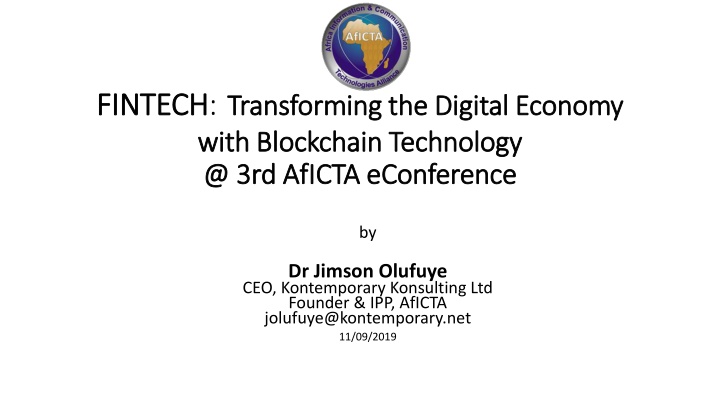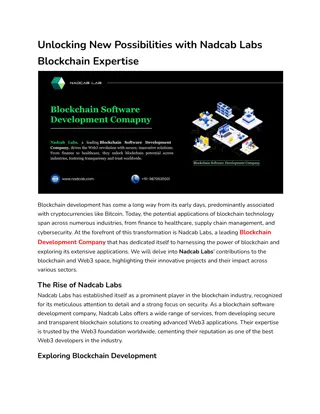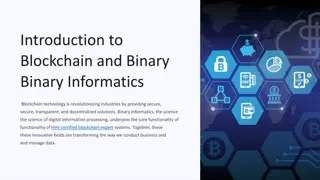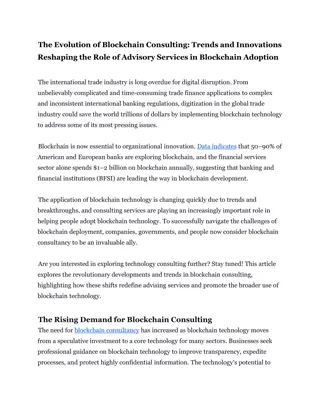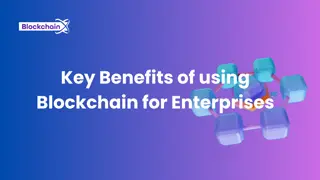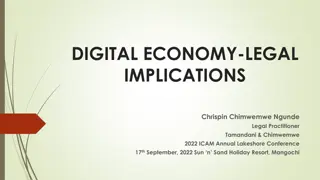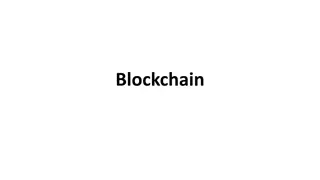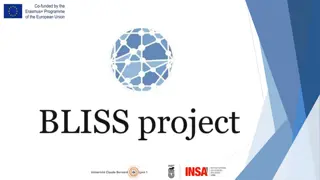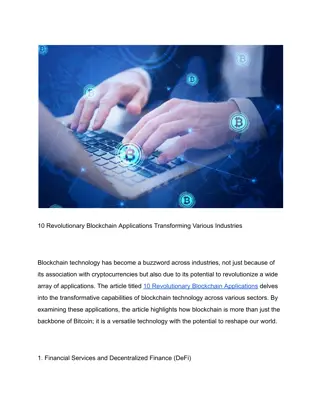Transforming the Digital Economy with Blockchain Technology
Blockchain, a key component of Fintech, is revolutionizing various industries globally. Explore its workings, key characteristics, and the potential it holds for enhancing governance and transparency. Discover how Bitcoin utilizes blockchain technology and the challenges associated with distributed ledgers. Governments are also exploring blockchain's potential for national development.
Download Presentation

Please find below an Image/Link to download the presentation.
The content on the website is provided AS IS for your information and personal use only. It may not be sold, licensed, or shared on other websites without obtaining consent from the author.If you encounter any issues during the download, it is possible that the publisher has removed the file from their server.
You are allowed to download the files provided on this website for personal or commercial use, subject to the condition that they are used lawfully. All files are the property of their respective owners.
The content on the website is provided AS IS for your information and personal use only. It may not be sold, licensed, or shared on other websites without obtaining consent from the author.
E N D
Presentation Transcript
FINTECH FINTECH: Transforming the Digital Economy Transforming the Digital Economy with Blockchain Technology with Blockchain Technology @ 3rd AfICTA eConference @ 3rd AfICTA eConference by Dr Jimson Olufuye CEO, Kontemporary Konsulting Ltd Founder & IPP, AfICTA jolufuye@kontemporary.net 11/09/2019
AGENDA AGENDA Introduction What is FINTECH? What is Blockchain? How does BT work and key Characteristics? How the transaction steps work on Bitcoin? What are the challenges and Risks associated with Distributed Ledgers? Areas of Adaptation by Government for National Development Conclusion
Introduction Introduction Blockchain Technology (BT) (which is associated with cryptocurrencies and token networks (like Bitcoin, Ethereum etc) in particular is seeing a boom of trials by some of the world s largest banks, insurance companies and manufacturing businesses thereby underscoring its growing importance. Considering the three core features of BT - immutability, transparency and autonomy, governments are not left out in exploring how BT can foster good governance, eliminate corruption and provide democratic dividend for the people.
What is FINTECH? What is FINTECH? Financial technology (Fintech) is portmanteau of two words Financial and Technology . It describes new tech that seeks to improve and automate the delivery and use of financial services. At its core, fintech is utilized to help companies, business owners and consumers better manage their financial operations, processes, and lives by utilizing specialized software and algorithms that are used on computers and, increasingly, smartphones.
What is Blockchain? What is Blockchain? Simply put, Blockchain is secure creation and access of distributed ledgers driven by cryptography.
How does BT work and key Characteristics? How does BT work and key Characteristics? Bitcoin is a strong example of how blockchain infrastructure and technical elements operate. The technology used to record and store transactions for Bitcoin is applicable to a variety of industries outside of this specific market. The technology behind Bitcoin: 1.Embedded cryptography: The technology automatically integrates public - and private - key cryptography as a default implying that all transactions are natively encrypted with public and private keys. To unlock a particular transaction or smart contract on a blockchain, one would need to apply a specific private key to the public address. The public address encrypts the data so that it can only be unlocked with that specific private key.
How does BT work and key Characteristics?... How does BT work and key Characteristics?... 2. Secure blocks: Data are group in a tamper-proof chain. As records are verified by the network members, they are added in blocks to block chain. 3. Proof of work verification: Proof of work is required for verification. The data is run through a cryptographic puzzle, which contributors to the network are asked to verify by solving. This requires sufficient computing power to decode the puzzle, thus the proof of work . Due to the large workload, there is consideration to embrace proof of stake instead.
How does BT work and key Characteristics?... How does BT work and key Characteristics?... 4. Transaction payments: Incentives are required to add transactions to a blockchain. The participants - known as miners in the Bitcoin network - are rewarded with Bitcoins for their work. 5. Network data security and integrity: The moment data is appended to the blockchain, it is encrypted with a unique hash then copied to all of the nodes on the system.The transactions are connected by a hash generated by the prior transaction of the blockchain. Therefore, if someone tries to alter the transaction, it alters the data in the entire blockchain down the line and that is an instant indication of fraud.
How does BT work and key Characteristics?... How does BT work and key Characteristics?... 6. Peer to peer: The data in a blockchain is replicated to host or peers in a peer-to-peer network such that if there a change in one, it mean the data has been compromised.
How the transaction steps work on Bitcoin? How the transaction steps work on Bitcoin? Step 1: A transaction is sent to a public address. The transaction is encrypted using a public and private key, which must be used at the same time. It is like a private message locked inside a locked mailbox for which the owner must have both the mailbox key and the key to the message. Step 2: The enrypted date is hashed (i.e. signed with cryptography) and broadcast to members who must use computing power to decode the hash to verify the data.
How the transaction steps work on Bitcoin? How the transaction steps work on Bitcoin? Step 3: Once the data (transaction) is verified, it is approved and added as a block of data to the blockchain. This copy is thereafter sent to the nodes of the network. Each new block is applied with a hash from the prior block, meaning data cannot be altered once it is added to the blockchain. Step 4: All transactions are timestamped to prevent duplicate transaction attempts.
What are the challenges and Risks associated with What are the challenges and Risks associated with Distributed Ledgers? Distributed Ledgers? Challenges 1. Scalability: The cheer computing power require to arrive at proof of work is a challenge for transaction scaling. 2. Transaction speed: At an average of 7 transactions per second compared to VISA s 56,000 transactions per second (ref 2015 report). The challenge of scaling is underscored here.
What are the challenges and Risks associated with What are the challenges and Risks associated with Distributed Ledgers? Distributed Ledgers? Challenges 3. Governance: Regulatory and legal questions such as who is in Charge? Where do you go to complain or regulate? Where is the legal governance of data? 4. User complexity: The BT can be complex and require management of cryptographic keys and addresses.
What are the challenges and Risks associated with What are the challenges and Risks associated with Distributed Ledgers? Distributed Ledgers? 5. Cost: BT is not yet proven to be cost effective as it is yet to be determined how much is to be invested to get a return on investment. 6. Power: In a proof of work system such as Bitcoin, computing power is the currency of the network. Computing strength consumes enormous amounts of power, ...
What are the challenges and Risks associated with What are the challenges and Risks associated with Distributed Ledgers? Distributed Ledgers? Risks As BT gains momentum, there are five (5) IT risk areas that are of significance when embarking on blockchain driven projects. They are: Cyber and Information risk, architecture and design risk, IT compliance risk, third party and vendor risk and integration risks.
Areas of Adaptation by Government Areas of Adaptation by Government for National Development for National Development Several areas of BT application exist for government vertical processes in the following sectors: 1. Financial industry: With Central Bank of Nigeria and other banks participating to tackle corruption. 2. Cadastral Record Management: Land and property management can be well served with BT
Areas of Adaptation by Government Areas of Adaptation by Government for National Development for National Development 3. Health Management: BT would enable reliable, secure and trust worthy health record of citizens 4. Identity Management: This has the potential of eliminating identity theft. 5. Legal records and contract management 6. Oil and Gas transactions etc
Conclusion Conclusion As a disruptive technology, it is quite essential that proper preparation is carried out before BT is applied to government verticals. It is important that formal governance structures and procedures be established to reap the benefit of BT when applied.
Conclusion Conclusion The regulatory framework around BT is gaining momentum with the European General Data Protection Regulation that came into effect in May 2018 and the Nigerian Data Protection Regulation which was effetive in March 2019. Both are placing demand on compliance to use of personal data and the entend to which it can be stored, transferred and secured.
